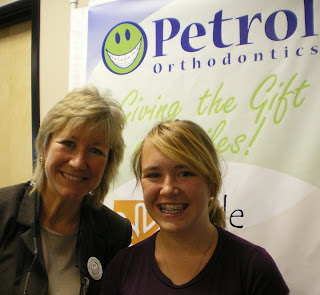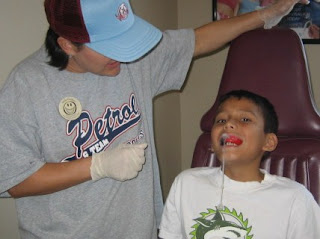The Inside Story
At Petrol Orthodontics, we are not only concerned about the correction of your teeth, but we are also concerned that your teeth remain as nice as they possibly can. A tongue thrust can cause your teeth to move even if you are wearing retainers. That is why it is important that this habit be corrected while in braces. The following FAQs will help you to better understand what a tongue thrust is and how it is corrected:
Q. What is "tongue thrust"?
A. "Tongue thrust" is the everyday name for an orofacial muscle dysfunction. It refers to the resting of the tongue against the teeth, and/or pushing the tongue against the front or side teeth, or both, during swallowing. This force or pressure generally causes the teeth to move.
Q. Is this something new?
A. Although information about tongue thrust is not yet widely known, the dental field has been studying the problem since the 1930's. In addition, speech pathologists began actively doing research and therapy for tongue thrust in the 1950's, Research and treatment is ongoing today.
Q. Do many people have this problem?
A. You're definitely not alone! A tongue thrust type of swallow is present in all babies, in about half of the population of five-year-olds, and in about one third of eight-year-olds. This is the age when it is most noticeable; it is also present in one-fourth to one-third of adults.
Q.
Do I really swallow that often to hurt anything? And how does swallowing affect the position of my teeth?
A. Most people swallow between 800-1500 times each day. We all swallow saliva 24 hours a day, in addition to liquid and food during meals and snacks. A person with a tongue thrust problem exerts at least a pound of pressure against the teeth every time he or she swallows. This frequent force, combined with resting the tongue against the teeth most of the day and night, can potentially cause considerable tooth movement.
Q. Now that I'm aware of the problem, couldn't I correct it on my own?
A. Trying to do this does not usually result in a permanent change. Learning the new swallowing technique involves more than a position change. It is a series of movements requiring the coordinated efforts of eight oral-facial muscles. Normally, people with a tongue thrust problem use only one or two muscles.
Q. What will happen if I don't change my tongue thrust swallowing pattern?
A. The end result is that your teeth may go back to, or stay, in their malocclusion. Your open bite, or over jet (protrusion of the teeth), or spaces between your teeth, will remain the same, or possibly get worse. If you don't have braces on your teeth yet, this is the ideal time to begin therapy! Otherwise, your teeth may continue to move in the direction that you don't want them to. Braces may only temporarily fix the problem. Relapse is very probable.
Q. I am already wearing braces. Why wasn't I told about this problem sooner?
A. Tongue thrust is not always readily observable at first glance. Although most orthodontists/dentists and their staffs thoroughly check every patient, at times, for various reasons, the tongue thrust is not identified right away. When the teeth are especially difficult to correct or they relapse into their former position, this then signals a potential tongue thrust problem. As both professionals and the general public become more informed about this muscular dysfunction, it is anticipated that it will be identified sooner in the orthodontic process.
However, you should be aware that if you are currently wearing braces, your tongue thrust could be competing with the re-alignment of your teeth and interfering with the purpose of the braces. You could end up wearing your braces longer than you had planned.
If you have worn braces, and they are now off, there is a good possibility that your teeth may lapse back to or near their original position. We certainly don't want that to happen!
Q. I'm still not sure that I (or my child) have this problem. What are some of the symptoms of tongue thrust?
A. Some of the symptoms of a possible tongue thrust problem are:
1. Low, forward tongue resting posture.
2. Breathing through an open mouth, instead of the nose.
3. Thumb-sucking, as a small child.
4. Problems saying the "s" sound. If you're still not sure, pay attention to where you place your tongue when you are relaxed. Does your tongue rest in the middle of your mouth and/or does it touch the front teeth?
Q. Is there a "best" age to successfully correct a tongue thrust habit?
A. A mature nine-year-old can usually understand the principles of the full therapy program, and will accept the responsibility for practicing. However, younger children can learn basic corrective techniques.
Q. Is there an upper age limit for successful therapy?
A. Happily, there is no upper age limit, Adult patients are well motivated, practice faithfully, and consequently, make excellent progress.
Q. I've been swallowing this way for a long time. Does "myo-functional therapy" really work to correct my tongue thrust?
A. Yes. Myo-functional tongue thrust therapy really can work, and it can be the critical factor in maintaining your straight teeth. Although most of us typically don't think about how we swallow, we can learn to focus on the swallowing process and make changes. The activities are easy to understand and to do.
Q. What should I look for when choosing a tongue thrust therapist?
A. My staff and I are certified to provide Tongue Thrust Therapy. We are one of three orthodontic practices nationwide certified to provide Tongue Thrust Therapy by Dr. Randall Jenks, who holds a PhD is speech and language therapy from University of California San Diego.

By providing Tongue Thrust Therapy in our office we assure positive results concurrently with orthodontic treatment









